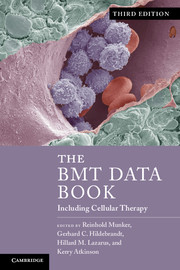Book contents
- Frontmatter
- Contents
- List of contributors
- Foreword
- Preface
- Acknowledgments
- Section 1 Basic science
- Section 2 Hematologic malignancies
- Section 3 Solid tumors
- Section 4 Nonmalignant disorders
- Section 5 Cellular therapy
- Section 6 Practical aspects and procedures
- Section 7 Complications
- 23 Pathobiology of graft-versus-host disease
- 24 Diagnosis and treatment of graft-versus-host disease
- 25 Management and prophylaxis of infections after BMT/SCT
- 26 Organ-related and miscellaneous complications
- Section 8 The BMT/SCT pharmacopoeia
- Section 9 HLA-testing and laboratory medicine
- Appendix Guide to the internet and literature databases relevant for BMT/SCT
- Index
- References
23 - Pathobiology of graft-versus-host disease
Published online by Cambridge University Press: 05 August 2013
- Frontmatter
- Contents
- List of contributors
- Foreword
- Preface
- Acknowledgments
- Section 1 Basic science
- Section 2 Hematologic malignancies
- Section 3 Solid tumors
- Section 4 Nonmalignant disorders
- Section 5 Cellular therapy
- Section 6 Practical aspects and procedures
- Section 7 Complications
- 23 Pathobiology of graft-versus-host disease
- 24 Diagnosis and treatment of graft-versus-host disease
- 25 Management and prophylaxis of infections after BMT/SCT
- 26 Organ-related and miscellaneous complications
- Section 8 The BMT/SCT pharmacopoeia
- Section 9 HLA-testing and laboratory medicine
- Appendix Guide to the internet and literature databases relevant for BMT/SCT
- Index
- References
Summary
Introduction
The number of allogeneic HCTs has continued to increase, with more than 20 000 allogeneic transplantations performed annually. The GVL/GVT effect during allogeneic HCT effectively eradicates many hematologic malignancies (Appelbaum, 2001). The development of novel strategies that use DLI, non-myeloablative conditioning, and CBT have helped expand the indications for allogeneic HCT over the last several years, especially among older patients (Welniak et al., 2007). Improvements in infectious prophylaxis, immunosuppressive medications, supportive care and DNA-based tissue typing have also contributed to improved outcomes after allogeneic HCT (Appelbaum, 2001). Yet the major complication of allogeneic HCT, GVHD, remains lethal and limits wider application (Ferrara & Reddy, 2006; Welniak et al., 2007). Depending on the time at which it occurs after HCT, GVHD can be either acute or chronic (Deeg, 2007; Lee, 2005; Weiden et al., 1979; Weiden et al., 1981). Acute GVHD is responsible for 15%–40% of mortality and is the major cause of morbidity after allogeneic HCT, while chronic GVHD occurs in up to 50% of patients who survive three months after HCT (Appelbaum, 2001; Lee, 2005).
The GVH reaction was first noted when irradiated mice were infused with allogeneic BM and spleen cells (van Bekkum & De Vries, 1967). Although mice recovered from radiation injury and BM aplasia, they later died with “secondary disease” (van Bekkum & De Vries, 1967), a phenomenon subsequently recognized as acute GVHD. Three requirements for the development of GVHD were formulated by Billingham (Billingham, 1966). First, the graft must contain immunologically competent cells, now recognized as mature T-cells. In both experimental and clinical allogeneic BMT, the severity of GVHD correlates with the number of donor T-cells transfused (Kernan et al., 1986; Korngold & Sprent, 1987). The precise nature of these cells and the mechanisms they use are now understood in greater detail (discussed later). Second, the recipient must be incapable of rejecting the transplanted cells, that is, immunocompromised.
- Type
- Chapter
- Information
- The BMT Data BookIncluding Cellular Therapy, pp. 297 - 310Publisher: Cambridge University PressPrint publication year: 2013



